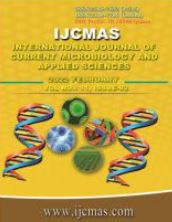


 National Academy of Agricultural Sciences (NAAS)
National Academy of Agricultural Sciences (NAAS)

|
PRINT ISSN : 2319-7692
Online ISSN : 2319-7706 Issues : 12 per year Publisher : Excellent Publishers Email : editorijcmas@gmail.com / submit@ijcmas.com Editor-in-chief: Dr.M.Prakash Index Copernicus ICV 2018: 95.39 NAAS RATING 2020: 5.38 |
The environmental degradation caused globally by crude oil and its by-products have become a menace that must be addressed. The pollution of soil has reduced the land use and the ecosystem functions of the soil have been adversely affected. It has become pertinent that ecologically friendly remediation approaches be adopted to restore the fertility of the soil and in essence its ecosystem functions. Nitrogen is a growth-limiting nutrient that cannot be assimilated without microorganisms, an increase in nitrogen-fixing bacteria after bioremediation is an indication of restoration. The soil samples were analyzed for physicochemical characteristics such as pH, total organic nitrogen (TON), electrical conductivity (Ec), and phosphorus. The microbiological characterization was done for total heterotrophic bacteria (THB) using plate count agar (PCA), the hydrocarbon utilizing bacteria was done using Mineral salt agar (MSA). The THB obtained in the study was2.4 x 104, 1.1 x 104, and 3.4 x 104, the HUB was0.1 x 103, 1.8 x 103, and 2.4 x 103. The bacterial isolates obtained in the study are Arthrobacter sp, Pseudomonas sp, Nitrosomonas sp, Bacillus sp, Micrococcus sp, Staphylococcus sp, and Escherichia sp. The degradative potential of these isolates was analyzed, the absorbency of the bacterial isolates was done for two different wavelengths (370 and 570). The degradative potential of the isolates was higher at the wavelength of 570. These organisms will be effective as a consortium for further hydrocarbon degradative study.
 |
 |
 |
 |
 |